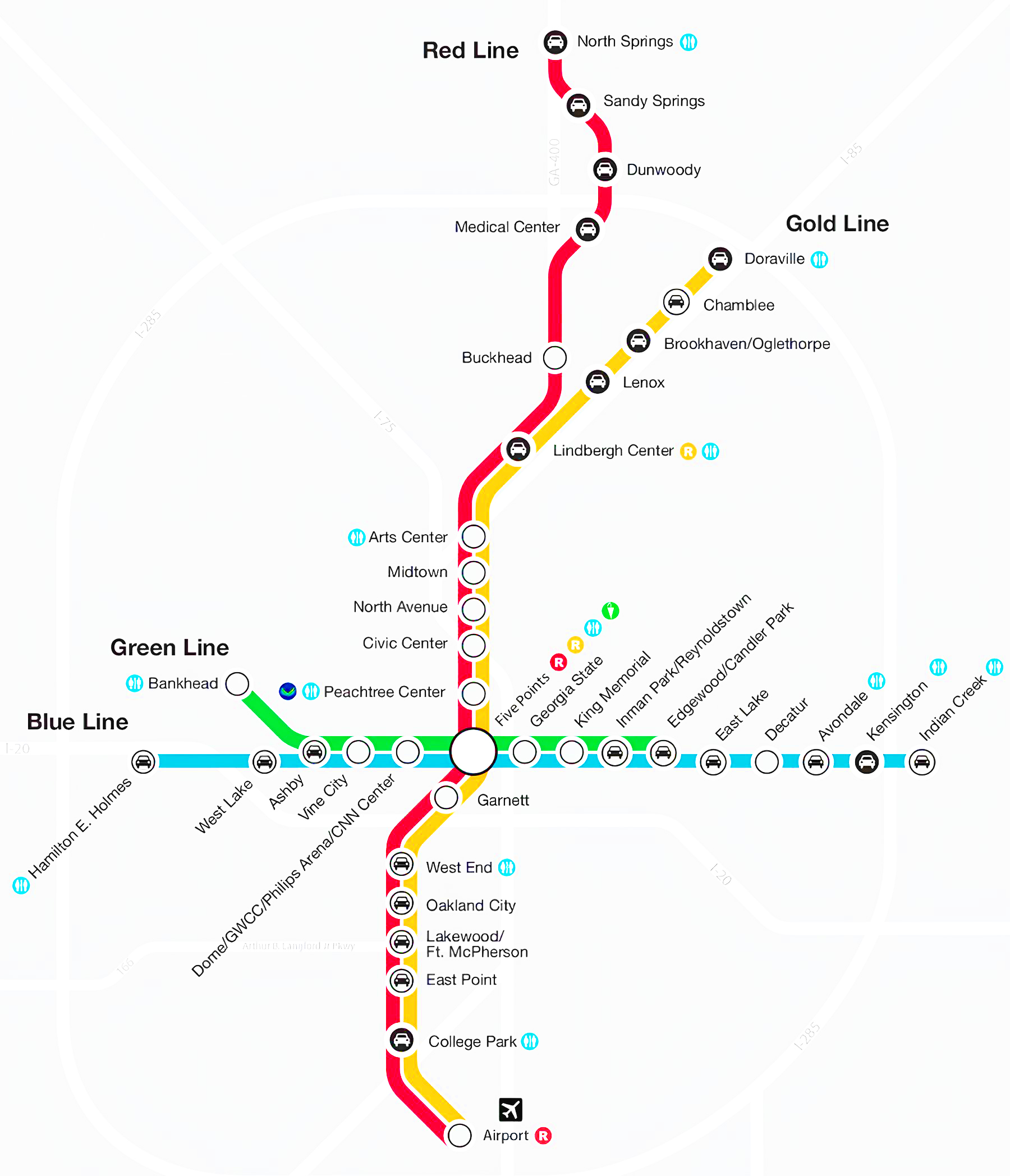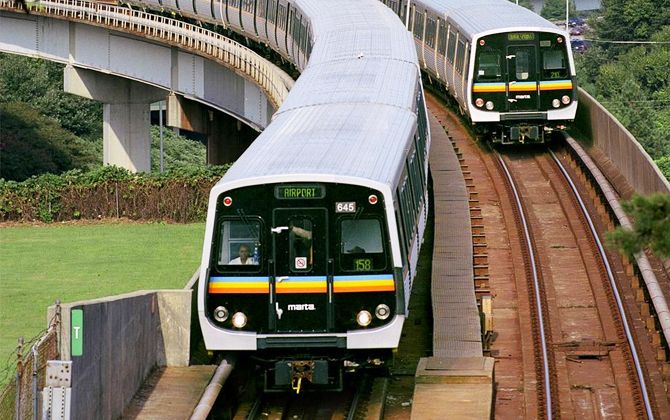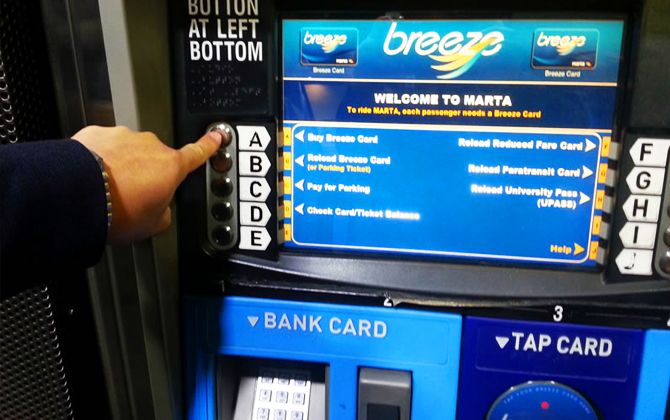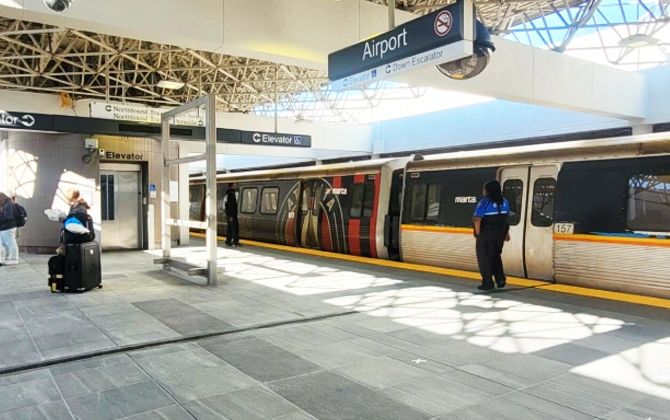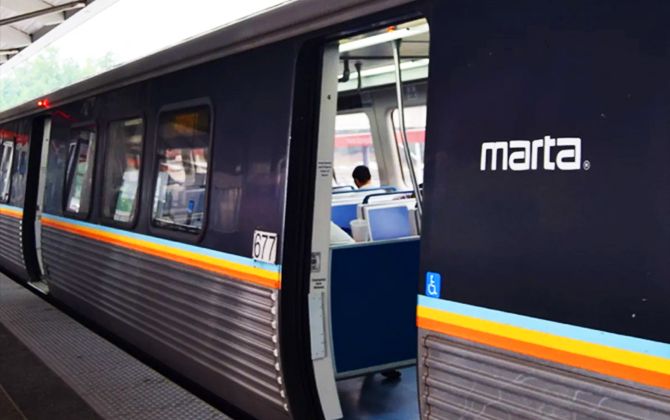The Metropolitan Atlanta Rapid Transit Authority (MARTA) is the main public transit system in Atlanta. It operates a wide bus network and a four-line rapid rail system. The rail network covers 48 miles (77 km) with 38 stations across Fulton, DeKalb, and Clayton counties.
MARTA’s rail lines are color-coded (Red, Gold, Blue, Green) and all intersect at Five Points station, the central hub in downtown Atlanta. As of 2026, MARTA serves over 96,000 riders on an average weekday.
Atlanta Metro Map
The MARTA rail map forms a “T” shape across Atlanta. Two north–south lines (Red and Gold) run from Five Points into the northern suburbs and south to the airport. Two east–west lines (Blue and Green) connect west Atlanta, downtown, and the east side. In total, the system has four lines: Red, Gold, Blue, and Green.
The Red and Gold Lines share tracks through Five Points heading south, while the Blue and Green Lines share tracks through Five Points heading east. Major transfer points, especially Five Points and Lindbergh Center, connect rail lines with bus routes.
Map of Atlanta Metro showing different lines. Click on the map to enlarge it or download the Atlanta Metro MARTA map in PDF format.
Lines and stations
MARTA operates four rail lines, each serving different parts of Atlanta and its suburbs.
Red Line (North–South)
Runs from North Springs in north Atlanta through Buckhead and Midtown to Five Points, then south to the Airport.
Major stops include Buckhead, Lindbergh Center, Arts Center, Midtown, North Avenue, Civic Center, Peachtree Center, and Five Points. South of downtown, it serves Garnett, West End, Oakland City, Lakewood/Ft. McPherson, East Point, College Park, and Airport.
The Red Line provides direct service between the northern suburbs and Hartsfield-Jackson Atlanta International Airport.
Gold Line (North–South)
Starts at Doraville in the northeast, serving Chamblee, Brookhaven, and Lenox before meeting the Red Line at Lindbergh Center. From there it follows the same route south through Arts Center, Midtown, North Avenue, Civic Center, Peachtree Center, Five Points, Garnett, West End, Oakland City, Lakewood/Ft. McPherson, East Point, College Park, and Airport.
The Gold Line covers different northern suburbs but shares tracks with the Red Line from Lindbergh Center southward.
Blue Line (East–West)
Runs from Hamilton E. Holmes in west Atlanta through West Lake and Ashby, then passes Vine City, GWCC/CNN Center, and Five Points downtown. East of downtown, it continues through Georgia State, King Memorial, Inman Park, Edgewood/Candler Park, East Lake, Decatur, Avondale, Kensington, and ends at Indian Creek. Key stops include CNN Center (for Georgia World Congress Center), Five Points, and King Memorial (near Sweet Auburn).
Green Line (West–East)
Begins at Bankhead in west Atlanta, running through Ashby, Vine City, GWCC/CNN Center, and Five Points. From there it continues east along the Blue Line tracks through Georgia State, King Memorial, Inman Park, and ends at Edgewood.
The Green Line branches west to Bankhead but otherwise shares tracks with the Blue Line downtown and eastward.
Operating Hours and Timetables
MARTA trains run about 20 hours a day. On weekdays, service is from 4:45 AM to 1:00 AM. On weekends, trains start later, around 6:00 AM, and finish at 1:00 AM. Buses generally operate 5:00 AM–1:00 AM on weekdays and 5:00 AM–12:30 AM on weekends. The first trains leave early morning (e.g. from Airport Station around 4:36 AM), and the last trains return close to 1:00 AM. Holiday schedules may vary, so it’s best to check MARTA updates in advance.
On weekdays during peak hours, trains arrive every 10–12 minutes. Midday and evening service is less frequent, about every 12–20 minutes. On weekends, trains usually run every 20 minutes. At busy stations like Five Points, weekday peak intervals are about 10 minutes.
Fare and Ticket Information
MARTA uses the Breeze Card for fare payment. The card costs $2 (USD) / ₩2, and can be reloaded with value or passes. A single-ride fare (any distance) is $2.50 (USD) / ₩2.50. Reduced fares for seniors, disabled riders, and Medicare cardholders are $1.00 (USD) / ₩1.00. Children up to 46 inches (117 cm) tall ride free with a paying adult.
| Fare/Ticket Type | Price (USD) |
|---|---|
| One-way Train (Adult) | $2.50 (USD) / ₩2.50 |
| Senior/Disabled/Medicare Fare | $1.00 (USD) / ₩1.00 |
| 1-Day Unlimited Pass | $9.00 (USD) / ₩9.00 |
| 7-Day Unlimited Pass | $23.75 (USD) / ₩23.75 |
| 30-Day Unlimited Pass | $95.00 (USD) / ₩95.00 |
| 10-Ride Multi-Ride Ticket (Adult) | $25.00 (USD) / ₩25.00 |
| 20-Ride Ticket (Adult) | $42.50 (USD) / ₩42.50 |
Breeze Card vending machines at all stations accept cash or credit/debit cards. Day, week, and month passes allow unlimited rides on both trains and buses for the valid period.
MARTA Service Connections
MARTA rail and bus services form one integrated system. Every rail station has nearby bus stops serving local and regional routes. Major stations act as transfer hubs. For example, Five Points Station connects to many bus lines, including routes 3, 21, 40, 49, 55, 107, 186, and 813. Lindbergh Center Station connects to routes 5, 6, 30, 39, 809, as well as regional shuttles.
Transfers between bus and rail are seamless with the Breeze Card. MARTA also links with other transit providers: the Atlanta Streetcar stops near Five Points and Peachtree Center, while regional systems like CobbLinc and Xpress connect at select MARTA stations. Arts Center Station, for instance, connects with CobbLinc and Gwinnett Transit. Many rail stations also function as park-and-ride hubs.
Airport Connection
MARTA provides direct rail service to Hartsfield-Jackson Atlanta International Airport. The Airport Station is inside the domestic terminal, between North and South baggage claim areas. It is the southern end of both the Red and Gold Lines. Trains run frequently between the Airport and downtown (Five Points), with trips averaging under 30 minutes. For example, the ride from Lindbergh Center to the Airport takes about 26 minutes (42 km / 26 miles).
Passengers board directly from the terminal. For international flights, free connections to the international terminal are available via the ATL SkyTrain or shuttle buses outside baggage claim.
After evening rush hours, some trains may skip Buckhead and Midtown stations. In that case, riders should transfer at Lindbergh Center to continue north on the Red Line. Trains are cleaned at the Airport terminal after each arrival, so brief delays at the platform are normal.
The Airport Station has no bus routes, but taxis and rideshare services are available at the ground level outside the station.
MARTA Travel Tips
Plan ahead: Check schedules or the MARTA app for first and last trains. Since service ends around 1:00 AM, plan late-night trips carefully. Use the trip planner or customer service for help with routes.
Peak vs. off-peak: Trains are busiest during weekday rush hours (6:00–9:00 AM and 4:00–7:00 PM). For more space, travel midday or late evening.
Payment: Buy and reload Breeze Cards at station kiosks. Day or week passes are good for multiple trips. Transfers between bus and rail are free within 3 hours using the Breeze system.
Airport travelers: Keep luggage close. MARTA is generally safe, but trains are cleaned at the Airport station before departure, so allow extra time. Staff are available at Airport Station to assist travelers.
Safety: Stations and trains have cameras and frequent police patrols. Stay aware of belongings. MARTA’s Safety & Security guide provides more tips on safe riding and station etiquette.
Station amenities: Most stations have parking, bike racks or lockers, and real-time arrival displays. Five Points and Lindbergh Center offer larger facilities. Escalators and elevators are available, though maintenance may occasionally affect access.
Language assistance: Signs and announcements are in English. Customer service can provide translation support if needed.
Behavior: Let riders exit before boarding, keep aisles clear, and stand back from doors. If traveling with luggage or strollers, avoid peak hours when possible.
Guidelines
- The toilets at all stations are open between 6:00 am and 7:00 pm. In particular, the toilet at Five Points Station is open until 22:00.
- Food can only be consumed at the stations.
- Drinks may only be consumed from lidded containers.
- The possession of firearms in the Metro is subject to a legal firearms licence.
- Listening to music is allowed, provided that you use headphones or keep the volume low.
- Littering is prohibited.
- Small caged animals, police dogs and guide dogs are the only animals allowed on the Metro premises.
- The Metro is a non-smoking environment.
- Graffiti or similar defacement of Metro property is prohibited.
- Begging is not permitted within the Metro.
Historical Overview
MARTA began as a bus system in the early 1970s and expanded to rail in 1979. In 1971, voters in Fulton and DeKalb counties approved a 1% sales tax to fund the system. The first heavy rail segment opened on June 30, 1979. Through the 1980s and 1990s, MARTA added several stations and extended service. Expansion slowed after the late 1990s due to political and funding challenges.
In 2016, Atlanta-area voters approved a major sales tax increase under the “More MARTA” initiative. This program funds new rail and bus rapid transit projects. Since then, MARTA has focused on upgrades and gradual system expansion.
Interesting Facts
System Size: The rail network spans 48 miles (77 km) with 38 stations. On weekdays in 2026, the system carries about 96,000 rail riders.
National Rank: MARTA ranks as the eighth-largest heavy-rail transit system in the United States by ridership.
Ridership: In 2024, MARTA recorded about 65.2 million total boardings across bus and rail. This included roughly 29.4 million rail rides and 34.6 million bus rides.
Launch Date: MARTA rail officially began service on June 30, 1979, with stations such as North Springs and Arts Center opening that day. Hamilton E. Holmes, the first above-ground station, opened later on December 22, 1979.
Operating Voltage: Trains run on 750 V DC third-rail power and can reach speeds up to 70 mph (113 km/h).
Unique Services: MARTA introduced fare cards in 2008 and now offers the Breeze Mobile app. A new system (AFC 2.0) will soon allow direct entry with contactless credit cards.
Coverage: MARTA rail serves Atlanta’s Fulton, DeKalb, and Clayton counties. It does not extend into Cobb or Gwinnett counties, though buses and shuttles connect those areas.
Service Innovations: MARTA runs Artbound, a public art program with installations at many stations. It also operates a 24/7 customer service center and promotes safety through the “See Something, Say Something” campaign.
Points of Interest
MARTA offers convenient access to Atlanta’s major attractions:
- Downtown Atlanta: The Georgia Aquarium and World of Coca-Cola are a 10–15 minute walk from CNN Center Station (Blue/Green) or Peachtree Center Station (Red/Gold). Centennial Olympic Park, the Children’s Museum, and the College Football Hall of Fame are nearby. The Center for Civil and Human Rights and CNN Studio Tour are close to CNN Center Station. The Georgia State Capitol and Atlanta Convention Center can be reached via Five Points, Georgia State, or Peachtree Center stations.
- Midtown: Arts Center Station (Red/Gold) serves the High Museum of Art, Alliance Theatre, and Atlanta Symphony Hall. Piedmont Park is a short bus ride from Arts Center or Midtown stations. The Fox Theatre and Atlantic Station are accessible by short bus trips from Midtown or Arts Center.
- Sweet Auburn / South Downtown: The Sweet Auburn district—including the Martin Luther King Jr. National Historic Site, King Center, and Auburn Avenue—is a short walk or bus ride from King Memorial Station (Blue/Green). Oakland Cemetery is adjacent to King Memorial. Grant Park and Zoo Atlanta are located a few blocks south.
- Buckhead / Lenox: Lenox and Brookhaven stations (Red/Gold) serve the Buckhead shopping district, including Lenox Square Mall and Phipps Plaza. Midtown Station is close to major office towers and tech centers.
- Airport: Hartsfield-Jackson Atlanta International Airport is directly connected by Airport Station (Red/Gold), offering the fastest route into downtown hotels and attractions.
- Emory University and CDC: A free Emory shuttle connects Lindbergh Center Station to the campus and CDC. A future Clifton Corridor BRT line will extend direct service.
- University of Georgia (Buckhead campus): Accessible via Arts Center and Buckhead stations.
- Georgia Tech: Located near North Avenue Station (Red/Gold) in Midtown, about a 10-minute walk to campus.
- MARTA stations are located close to many visitor destinations, from downtown landmarks to Midtown museums, Sweet Auburn historic sites, and Buckhead shopping. By using MARTA’s trip planner or visitor guides, tourists can easily navigate Atlanta by transit.
How To: Navigating the MARTA Train for Beginners
Planned Upgrades
MARTA is carrying out its largest expansion and modernization in decades, funded by the 2016 “More MARTA” initiative. Major projects include:
CQ400 Next-Gen Trains: New CQ400 railcars are arriving, featuring open gangways, upgraded interiors, charging ports, and digital displays. These trains will boost capacity and rider comfort.
Communications-Based Train Control (CBTC): A modern signaling system is being installed to let trains run closer together, improving safety and reliability.
Bus Rapid Transit (BRT) Lines: The MARTA Rapid network is expanding. The Summerhill BRT (Rapid A-Line) is under construction, covering 5.4 km (3.3 miles) with 14 stations and zero-emission buses. Future BRT routes are planned on Campbellton Road, Southlake Mall, and State Route 54. These will use dedicated lanes and electric, ADA-accessible buses.
Arterial Rapid Transit (ART) Corridors: Two new ART corridors—Cleveland Avenue (east–west) and Metropolitan Parkway (north–south)—will launch, totaling 15 km (9 miles). They will offer frequent service and upgraded stations, linking to East Point and West End MARTA stations.
Station Modernization: MARTA is investing about $1 billion to renovate all 38 rail stations. Five Points is being rebuilt as a modern transit hub, while Bankhead Station is expanding its platform. Upgrades include new lighting, signage, elevators, and amenities.
Transit Centers: New bus and rail hubs are planned in Clayton County, South DeKalb, and Stonecrest to improve regional connections.
Clifton Corridor (Atlanta–Emory): The proposed Lindbergh-to-Emory line will launch as a BRT route, with stations at Emory University, the CDC, and Druid Hills. Earlier light rail plans were dropped in 2023.
NextGen Bus Network: MARTA is redesigning bus routes to expand high-frequency service. Fifteen-minute service corridors will grow from 5 to 18 routes, with stronger weekend coverage.
Fare Payment Upgrade: The new AFC 2.0 system will introduce smartcard and phone payments, along with upgraded faregates.
Together, these projects will make MARTA faster, cleaner, and more reliable. The first CQ400 trains are scheduled for testing in late 2026 and full rollout in 2026. Investments in technology and zero-emission buses reflect MARTA’s commitment to sustainability.
